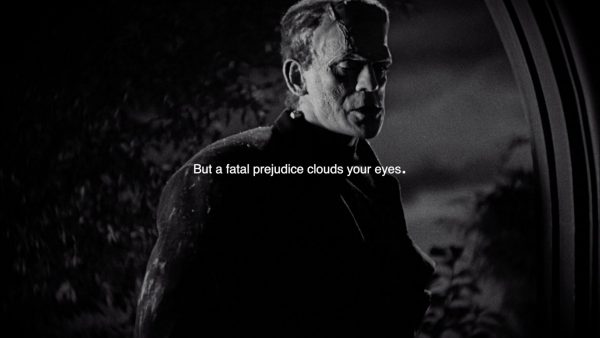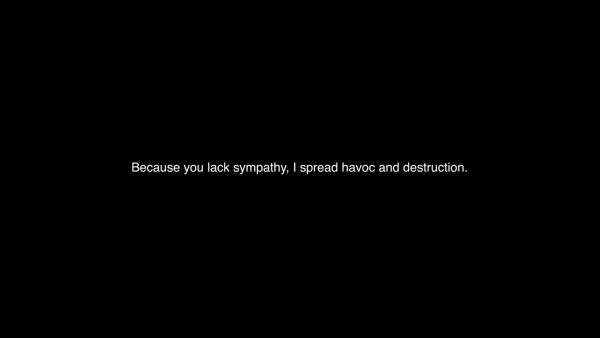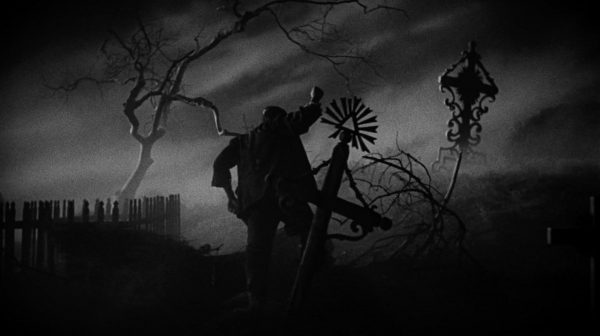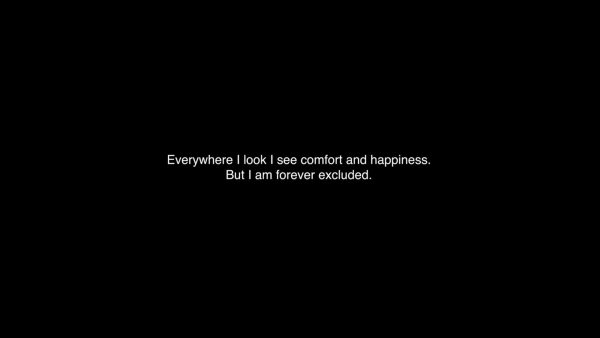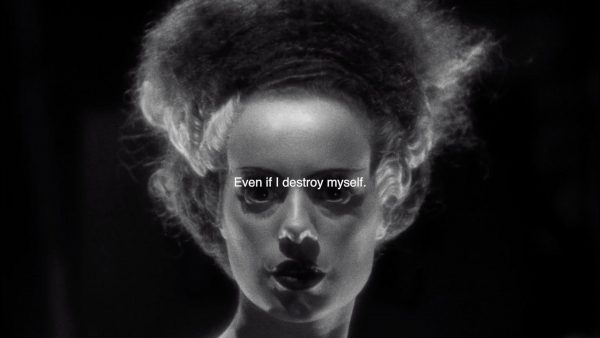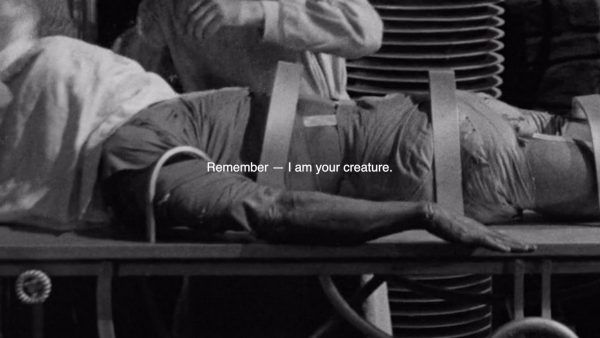The conceptual artist Silvia Kolbowski began working on her new video, That Monster: An Allegory (2018), in the immediate aftermath of Trump’s election. The air of American life was thick with animosity, and like soot from a forest fire, it spread far beyond the burn. Both sides of the political spectrum were consumed, in Kolbowski’s words, with such ‘sheer hatred’ that political disagreement became grounds to start a brawl or end a relationship. Grandmothers famously unfriended their grandchildren and in-laws refused to visit. Opting out of family holiday gatherings became not only common, but almost obligatory, if one’s family included resolute Trumpers. In November 2018, the liberal Democrat New York Times columnist Maureen Dowd wrote an op-ed anticipating an upcoming vacation with her brother, who was not only a Trump supporter, but a friend and defender of Brett Kavanaugh, the Republican Supreme Court justice accused of sexual assault. Dowd used the article to reflect on how (and whether) a relationship can persist across a sea of political difference. She was buried in backlash arguing that her concessions to her brother – the gestures necessary to preserve the relationship – were unethical and cowardly.
This sense of atmospheric hostility is born out by data. Both Republicans and Democrats view their counterparts as ‘closed-minded’, ‘immoral’, ‘lazy’, ‘dishonest’, ‘unintelligent’, and even ‘dangerous’. (Democrats fear that Republicans threaten their very being – their safety in the world as individuals – and Republicans fear that Democrats threaten the existence of America.) Surveys have historically assessed party contempt on a numerical scale, where zero represents total animosity and 100 warm affection. Since 2014, Democrats have thought worse of Republicans than they think of ‘big business’, and Republicans have thought worse of Democrats than they think of ‘people on welfare’. But the numbers continue to plummet. The last iteration of the survey, a 2016 Pew Research Center Study, registered record numbers of respondents who reported their position as zero, meaning they couldn’t imagine a purer vitriol.
As horrified as anyone else on the Left by Trump’s election, Kolbowski might have sharpened her anger, as so many did, but turned instead toward curiosity. Why, exactly, would anyone vote for Trump? ‘I hated,’ she writes, ‘what [the voters] stood for, the politics of racism and misogyny, and political ignorance… but I saw them from a different vantage point, higher and wider, and rather than just attack them, and put them in… a kind of untouchables category, I wanted to understand.’ Confronted with the inexplicable, Kolbowski went searching for an explanation.
Her artistic research involved tracking political animosity on Twitter threads and Reddit forums, where even innocent-seeming queries eventually imploded. She gauged the pitch of the conflict, and the way the tenor of disagreement choked out rational dialogue. The discord between Left and Right is sometimes explained with economic analysis or political history or sociological data, but Kolbowski decided that none of these could fully account for the savagery of the battle. What was missing was a psychoanalytic perspective, an understanding of the psychic history that might result in falling in thrall to a demagogue. Based on her research, Kolbowski’s goal was to ‘insert into the Left a conversation about the psyche’.
The source material for That Monster: An Allegory is the story of Frankenstein. Kolbowski’s script is drawn from Mary Shelley’s classic novel of 1818, and the images from James Whale’s 1935 Hollywood classic The Bride of Frankenstein. The piece is structured as two visually-identical 9-minute sequences, strung end to end, with an alternating soundtrack. The first sequence is accompanied by pensive music from Philip Glass’s Metamorphosis (1988), and the second is silent. This triad of source material – a nineteenth-century literary classic combined with an iconic Hollywood film combined with Glass’s late-twentieth-century symphonic cantata – might suggest a muddle, but in fact the video is as sparse and pithy as an Imagist poem, and provokes exactly the right proportion of feeling to thinking.
The basic action of the 18-minute piece is that a monster, who is by turns hurt, plaintive, and furious, addresses the viewer as if the viewer has caused its anguish. The interior voice of the monster, which is mainly represented by quotes drawn directly from Shelley’s text, appears as subtitles and intertitles, placed on top of and between clips from The Bride of Frankenstein. Sometimes the monster’s voice is a wounded, first-person lament – ‘I am filled with shame’, or ‘How hated I must be’ – but more often it’s a second-person harangue, a catalogue of recriminations: ‘You detest and spurn me’, ‘You try to block me from your sight’, ‘You call me stupid!’, and ‘You call me a burden!’
When set to Glass’s magisterial orchestrals, the film has stylised grandeur; the music prettifies the monster’s speech. The second cycle through the film, in silence, is comparatively graceless. Listening is uncomfortable, and also impossible to avoid, as if all the air has been sucked out of the room. The viewer becomes drawn in, implicated, and their reaction to the monster’s monologue is the central drama of the piece. Is the monster speaking to me? Do I deserve to be spoken to like this? What did I do? This doesn’t seem fair.
Written by a woman not yet 20 years old, the plot of Frankenstein centres on a brilliant scientist who stitches together a monster made of stolen body parts and animates it with electricity. It’s a miraculous achievement, but the scientist is disgusted and repelled by his creation. He vigorously denies that he has any obligation to the monster’s well-being and spends most of the novel running away. The monster fumes over the injustice of his situation – brought to life only to suffer – and his loneliness takes a wretchedly human aspect. He becomes mired in his melancholy thoughts, craves a friend, and eventually can’t endure another minute. His hurt boils over, and he seeks retribution. In the end, it’s not a macabre body that seals his fate, but the psychic trauma of rejection and loneliness. He wasn’t born a monster, but he becomes one by dint of cruelty.
The film clips that accompany the monster’s script repeat a few key sequences from The Bride of Frankenstein. A paragon of Hollywood horror, The Bride of Frankenstein is gloriously campy. The neck scars, bandages, and papier-mâché props all seem made for their Halloween reincarnation. But its lasting appeal is the subtlety with which Whale treats his theme. Born to a working-class family in Dudley, England, Whale was being held as a German prisoner in the Second World War when he decided to devote his life to theatre. He earned some acclaim as a director on Broadway in New York City before being lured to Hollywood in 1929, where he lived, as few did, as an openly gay man. Something in Whale’s temperament or biography must have complicated his understanding of monsters, such that his Frankenstein films were not the drivel his producer expected. Whale was bored with the idea of a fearsome visage that behaves with impunity. Much closer to his heart was the loneliness of being perceived as a monster.
In casting the role of monster, Whale sought to strike exactly the right balance of repellent and sympathetic. He refused to sign on the obvious choice: Hungarian-American actor Bela Lugosi. Sometimes styled as an Arab sheik and sometimes as a Latin rake, villains were Lugosi’s bread and butter, and he had just played Dracula (1931) to great acclaim. Lugosi was good at scary, Whale said, but he needed an actor who could also do ‘scared’. Whale selected instead Boris Karloff, who was about the same age as the director, in his early forties, and also British. Karloff had been working in Hollywood for over a decade, trying to leverage a series of bit parts into a career. He was grateful for the Universal contract, and only slightly piqued to be pegged as a mute freak.
Having cast the part, Whale set about creating the monster’s now-iconic costume. Working with make-up artist Jack Pierce, Whale attached bolts to the sides of Karloff’s neck and designed the trademark scar around the top of his skull. Steel struts were strapped along the actor’s spine and to each leg, so that his movements were crude and abrupt, as if some joints were missing. Karloff’s cheeks were sunken by removing a dental bridge, and he wore heavy, cumbersome shoes designed for asphalt pourers. Prosthetics made of putty, rolled cotton, and collodion were used to square Karloff’s forehead, and mortician’s wax weighted his eyelids.
The costume was so onerous that Karloff spent the next several decades agitating for laws that protected actors from severe discomfort on set. In all other respects, however, it was a wild success. The costume has become so commonplace that its original hideousness is hard to conceive, but the monster was terrifying enough in 1931 that a Universal Studios secretary fainted when she saw it, and Karloff was thereafter veiled on campus. A truly abominable creature was crucial to Whale’s concept. Can a monster be seen as anything else besides? The question could only be tested with the most repulsive of monsters.
Kolbowski has never stated outright that her allegorical monster represents Trump supporters, but this reading is often implied in the way she speaks about the piece. She describes how the Left monstracises the Right, and the casualness with which they espouse hate. Kolbowski courts the same complexity that James Whale sought to evoke in casting his monster. This enemy is undoubtedly repellent, but it’s possible to feel sympathy for them at the same time. In Kolbowski’s telling, Trump voters are demoralised and disenfranchised by global capitalism, and they feel abandoned and betrayed. The opioid crisis, the decline of American manufacturing and the usurpation of local business by big-box behemoths have left great swathes of the United States an arid ruin. The incongruence between the American dream – reward based on merit alone – and the American reality – downward mobility and diminishing opportunity – stifles lives in ways that urban coastal elites don’t seem to understand. Diminishing prospects are internalised as personal failure, and the resultant emotional landscape is a tangle of anger, grief, and depression, but most of all, Kolbowski argues, there is shame.
In a recent essay for the London Review of Books, Judith Butler follows Kolbowski in focusing on shame as central to Trump’s ascent. Trump’s shamelessness, Butler suggests, is intoxicating to someone inundated with shame. His imperviousness to judgment is such that he can’t effectively be judged. Despite a series of scandals, he remains untouched by the crumbling smallness that shame produces. His bionic immunity to shame seems a superpower worth admiring. ‘I WILL NEVER DROP OUT OF THE RACE,’ Trump tweeted in October 2016, in the aftermath of the release of the ‘Access Hollywood’ tape, in which he notoriously conflated seduction and assault (‘grab them by the pussy’). Trump’s on-camera boasts were so offensive that many on the Left assumed political death was imminent. And yet the opposite happened, and he was elected president – not in spite of the video, but in part because of it. Trump had been caught, and yet he refused to express regret. In the end, his brazenness was more impressive than his behaviour was repugnant. Shamelessness is the métier of Trump’s ascent.
The shame of the monster in That Monster: An Allegory can be easily mapped on the shame of an embittered voter, a voter who can’t help but admire Trump’s insouciance. But what follows next? If the monster is Trump’s voters, who is the scientist that made this monster? Over the course of Shelley’s novel, the roles of monster and scientist reverse themselves, and Kolbowski seems to be suggesting a similar eclipse between Left and Right: ‘You can’t quite locate who the monster is, or where the monster is.’ Democrats and Republicans are yoked together as staunchly as Frankenstein and his reviled creation. ‘Is that really me in that reflection?!’, asks the monster in Kolbowski’s piece, and the answer is hard to swallow.
